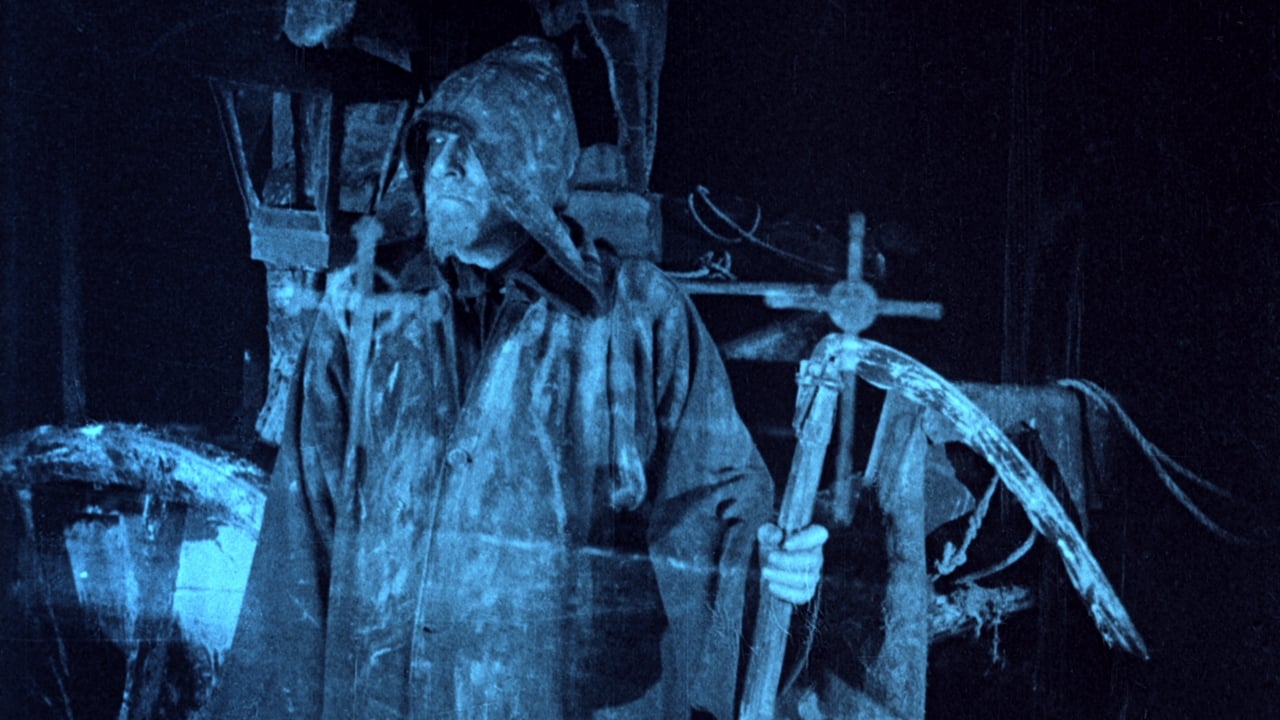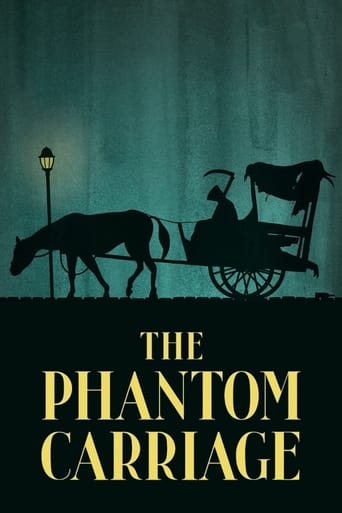



Awesome Movie
The plot isn't so bad, but the pace of storytelling is too slow which makes people bored. Certain moments are so obvious and unnecessary for the main plot. I would've fast-forwarded those moments if it was an online streaming. The ending looks like implying a sequel, not sure if this movie will get one
View MoreAll of these films share one commonality, that being a kind of emotional center that humanizes a cast of monsters.
View MoreOne of those movie experiences that is so good it makes you realize you've been grading everything else on a curve.
View MoreExperiencing THE PHANTOM CARRIAGE in the wee hours of new year's morning was as haunting as advertised. The film is nothing if not a technical accomplishment in visual storytelling and uses everything from translucent super-impositions, multiple-exposures, colour-tinted photography to create some stunningly unsettling imagery. The relatively straight-forward supernatural account is told through a complex series of meandering flashbacks and eventually works like morality tale much like Dickens' A Christmas Carol. My viewing pleasure was further elevated by the spectacularly moody experimental score by KTL - creepy, uninhibited, atmospheric that brilliantly complements the eerie visuals. Matti Bye's orchestral score is more conventionally buoyant and might get a tad overbearing at times.Going in I was aware of Bergman's reverence for TPC and the impact it had on some of his more famous works particularly THE SEVENTH SEAL and WILD STRAWBERRIES but had absolutely no clue that it also served as the inspiration for the famous "Here's Johnny" sequence in THE SHINING! THE PHANTOM CARRIAGE is one of the best advertisements of early, inventive bag-of-tricks film- making and necessary recounting of one of the most important life lessons - Not getting killed on New Year's Eve ;)
View MoreAll film lovers are aware of the genius of Chaplin and Keaton, but after just one viewing of Victor Sjostrom's "The Phantom Carriage", one will be tempted to include him in the pantheon of silent movie greats along with those better known artists. Not only did Sjostrom direct this film, but is credited as a writer and appeared as the principal character, David Holm. Nominally considered a horror film, I'd prefer to think of this story as a dark morality tale, evocative in many ways of Dickens' "A Christmas Carol", though with a decidedly more sinister bent.What's particularly striking about the film are the visual images created by Sjostrom's extensive use of double exposure to produce other worldly effects such as spirits rising from the recently deceased, or the ghostly image of the phantom carriage itself making it's appointed rounds. The story is told in five parts, although that didn't seem to be necessary as it flowed quite logically with the director's effective use of expository flashback scenes.As strong and unrelenting as the story is, I can't help but feel that it would have made an even more significant impact if in the finale, Sjostrom had allowed Holm's wife to follow through in her determination to leave her misery behind, the result of Holm's neglect and insufferable manner. Had Holm been allowed to 'remain dead', the eternal suffering he would have had to experience would have created one of the most powerful film endings in the history of cinema. As it is, it seemed Sjostrom took the more convenient and 'acceptable' way out for his character, and for movie goers who were still getting used to this new medium.Even so, this is a genuine film masterpiece, proving that even the earliest pioneers in the medium had important things to say and creative ways to say them. The story has a lot to offer about redemption and reconciliation, and effectively moves the principal character through various stages of personal torment before making amends for a misspent life.
View MoreWhen it comes to silent cinema, it's often relayed by newcomers that getting past the sound (or lack thereof) barrier is one that is difficult or near-impossible to do. Indeed, I remember my first venture into the silent realm and well, let's just say I wasn't convinced and moved away for near-on a decade. It goes without saying that, now with more than a handful of silent films (many now among my all-time favourite movies) under my belt, it's probably best to appreciate that some of cinema's forgotten treasures are easier to digest in a modern world than others. Or, at least for the uninitiated. The Phantom Carriage, I'd like to think, is one of those that crosses the barrier with ease. Whether through its imaginative storytelling, compelling visual effects that even a CGI-laden teenager might decree as "impressive", or the mere pace at which the film moves along; Victor Sjöström's 1921 classic is surely a film with no limitations set merely by its year of production. Firstly there's the plot which, although has been beaten to death on screens for the past 90 or so years, is one that is readily engaging and compelling to this day. Echoing more famous films made later down the line such as It's A Wonderful Life or Scrooge among many others, Sjöström's adaptation of Nobel prize-winning author Selma Lagerlöf's 'Thy Soul Shall Bear Witness!' (the fourth adaptation of Lagerlöf's novels by Sjöström and A-B Svenska Biografteatern) is a wonderfully- told moralistic epic that swoons, sways, crashes and burns as each of the film's characters play out their parts in what is, for the most part, a very grim and starkly depressing story. It's also a tale steeped in mysticism and fantasy, and while I'm usually rather prickly when it comes to such works, when done as well as it is here you can't help but be whisked along quite willingly for 100 minutes or so. It had some small hurdles in getting green-lit back in the day because of certain touchy belief-systems, but eventually the studio decided it would better served facing the wrath of an omniscient deity than Selma Lagerlöf. A wise choice indeed.As a direct result of the plot's reliance on the supernatural and occult, Phantom Carriage also boasts visual effects that far-exceeded anything else on screens at the time in terms of realism and clarity. Even on the newly-released Criterion blu-ray the scenes involving ghostly phantoms look stunning, even though the HD format has a tendency to do the exact opposite, often drawing attention to the primitive techniques used at certain points in history. On the flip side of the coin however, Lagerlöf's story isn't merely about ghosts in the literal sense; in fact, it probably spends more time developing and exposing the emotional phantoms that haunt its characters during their waking lives. Sjöström excels here also, blending powerful but natural performances from his more than capable cast (which includes himself in the lead role) with the detailed and strikingly-lit photography of Julius Jaenzon to cast light and shadows upon the characters' emotive faces, and most importantly, their conflicted hearts. Cinematographers were doing great work already across many studios at the time, and while The Phantom Carriage stands out as one of the very best, it's the realistic and very-seldom melodramatic performances led by Sjöström himself that break the standard for 1921 more than anything else.Rounding out the package on the restored Criterion release are two soundtracks, one of which I haven't heard at this time. The first is a fantastic chamber orchestra score penned by Matti Bye in 1998. It's not your typical silent-movie score by any means; often it will delve into bizarre interludes and stanzas that mirror the action well, but never distract from the film. The second, which I haven't gotten around to yet, is an experimental piece by KTL recorded for a Tartan DVD release in 2008. From what I've read elsewhere it's even better than Matti Bye's, and if it furthers Phantom Carriage's already strong ability to step out of its 95-year-old history and appeal to modern audiences, then by all means. Overall, I cannot recommend this one enough. Compelling and highly emotive character fantasy-drama, start to finish.
View MoreThis is certainly no product of Hollywood. The visuals have to be among the bleakest on record, where there's no attempt to prettify anything. So, what we've got as a result is the look and feel of what amounts to an alternate universe, grim and foreboding. It's this mood that carries the movie even when the acting and motivations falter. (I agree that Edit's undying love for David makes little sense within their skimpy context).To me the story comes across as a Christian fable of sin and redemption. David is able to escape his fate by a heartfelt act of bended-knee repentance, while the saintly Edit's prayers are finally answered. After all, David's salvation (and his family's) must be the result of supernatural intervention since the grim reaper admits he's powerless to alter anyone's fate. What the movie does so effectively is combine the subtle religious message with a supernatural mood that surprisingly suggests the absence of a divinity, an absence symbolized by the horror of the reaper and his ghostly carriage. No wonder religious existentialists like Ingmar Bergmann have been inspired by this early effort. (In fact, the hooded figure of "Death" in Bergmann's Seventh Seal {1956} bears a distinct resemblance to the reaper}.)The narrative is pretty uncompromising, conveying little distinction between reality, dream, or flashback. But I expect that adds to the overall surreal mood. The spectral images are well done for such an early stage in film technology and chillingly convey another dimension. Despite the occasional crudities the movie remains a highly compelling antique. But I wouldn't recommend it as relaxing entertainment.
View More